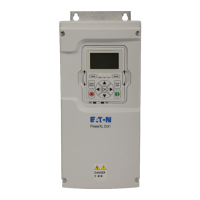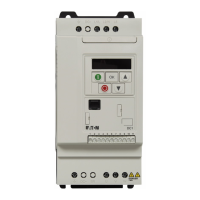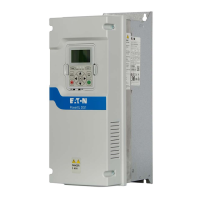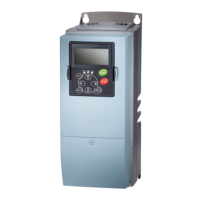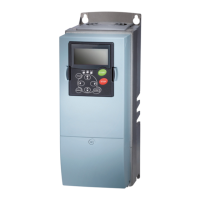26
Chapter 5—Motor and application
POWERXL SERIES VFD MN040002EN—February 2018 www.eaton.com
Parallel connection of several motors to one
frequency inverter
Figure 14. Parallel connection
Connecting motors in parallel reduces the load resistance
at the frequency inverter output. The total stator inductance
is lower and the leakage capacity of the lines greater. As a
result, the current distortion is greater than in a single-motor
circuit. To reduce the current distortion, you should use
motor reactors (see
in Figure 14) in the output of the
frequency inverter.
The current consumption of all motors connected in parallel
must not exceed the frequency inverter’s rated output
current I
2N.
Electronic motor protection cannot be used when operating
the frequency inverter with several parallel connected
motors. You must, however, protect each motor with
thermistors and/or overload relays.
The use of a motor protective circuit breaker at the
frequency inverter’s output can lead to nuisance tripping.
Motor and circuit type
The motor’s stator winding can be connected in a star or
delta configuration, in accordance with the rated operational
data on the nameplate.
Figure 15. Example of a motor ratings plate
Figure 16. Star and delta circuit types
The three-phase motor with the rating plate based on
Figure 15, can be run in a star or delta connection. The
operational characteristic curve is determined by the
ratio of motor voltage and motor frequency, in this case.
87 Hz characteristic curve
In the delta circuit with 400 V and 87 Hz, the motor
shown in Figure 15 was released with three times-fold
output(~1.3kW).
Because of the higher thermal loading, using only the
next higher motor output according to the list (1.1 kW)
is recommended. The motor (in this example) therefore
still has 1.47-fold higher output compared with the listed
output(0.75kW).
With the 87 Hz characteristic curve, the motor also works in
the range from 50 Hz to 87 Hz with an un-attenuated field.
The pull-out torque remains at the same level as in input
operation with 50 Hz.
The heat class of the motor must be at least F in
87 Hz operation.

